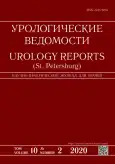Встречаемость мочевых камней различного химического состава в зависимости от уровня урикурии
- Авторы: Просянников М.Ю.1, Анохин Н.В.1, Голованов С.А.1, Константинова О.В.1, Сивков А.В.1, Аполихин О.И.1
-
Учреждения:
- НИИ урологии и интервенционной радиологии им. Н.А. Лопаткина - филиал ФГБУ «НМИРЦ» Минздрава России
- Выпуск: Том 10, № 2 (2020)
- Страницы: 107-113
- Раздел: Оригинальные статьи
- URL: https://journal-vniispk.ru/uroved/article/view/19223
- DOI: https://doi.org/10.17816/uroved102107-113
- ID: 19223
Цитировать
Аннотация
Введение. По современным представлениям одним из ключевых звеньев патогенеза мочекаменной болезни (МКБ) являются метаболические литогенные нарушения. Изучение комплексного влияния множества факторов на метаболизм пациента, страдающего МКБ, лежит в основе современных научных исследований патогенеза уролитиаза. В настоящей работе мы изучили частоту встречаемости мочевых камней различного химического состава при различных уровнях урикурии.
Материалы и методы. Проанализированы данные обследования 708 пациентов (303 мужчины и 405 женщин), страдающих МКБ. В процессе работы изучены результаты биохимического анализа крови и суточной мочи, анализа химического состава мочевых конкрементов. Для оценки встречаемости камней различного химического состава при различных уровнях урикурии производили ранжирование степени урикурии на 10 интервалов: от 0,4 до 14,8 ммоль/сут.
Результаты. При возрастании уровня мочевой кислоты в моче увеличивается и частота встречаемости конкрементов, состоящих из мочевой кислоты. Также при росте уровня урикурии выше 3,11 ммоль/сут отмечается стойкая тенденция к увеличению встречаемости кальций-оксалатных конкрементов. При увеличении уровня экскреции мочевой кислоты с мочой выше 3,11 ммоль/сут, напротив, отмечается снижение распространенности карбонатапатитных и струвитных камней. Наиболее часто при высоких уровнях экскреции мочевой кислоты встречаются мочекислые и кальций-оксалатные конкременты.
Выводы. Контроль за уровнем экскреции мочевой кислоты с мочой имеет принципиальное значение при кальций-оксалатном и мочекислом уролитиазе.
Ключевые слова
Полный текст
Открыть статью на сайте журналаОб авторах
Михаил Юрьевич Просянников
НИИ урологии и интервенционной радиологии им. Н.А. Лопаткина - филиал ФГБУ «НМИРЦ» Минздрава России
Email: prosyannikov@gmail.com
канд. мед. наук, заведующий отделом мочекаменной болезни
Россия, МоскваНиколай Валерьевич Анохин
НИИ урологии и интервенционной радиологии им. Н.А. Лопаткина - филиал ФГБУ «НМИРЦ» Минздрава России
Автор, ответственный за переписку.
Email: anokhinnikolay@yandex.ru
ORCID iD: 0000-0002-4341-4276
младший научный сотрудник, отдел мочекаменной болезни
Россия, МоскваСергей Алексеевич Голованов
НИИ урологии и интервенционной радиологии им. Н.А. Лопаткина - филиал ФГБУ «НМИРЦ» Минздрава России
Email: sergeygol124@mail.ru
д-р мед. наук, профессор, заведующий, научно-лабораторный отдел
Россия, МоскваОльга Васильевна Константинова
НИИ урологии и интервенционной радиологии им. Н.А. Лопаткина - филиал ФГБУ «НМИРЦ» Минздрава России
Email: konstant-ov@yandex.ru
д-р мед. наук, главный научный сотрудник отдела мочекаменной болезни
Россия, МоскваАндрей Владимирович Сивков
НИИ урологии и интервенционной радиологии им. Н.А. Лопаткина - филиал ФГБУ «НМИРЦ» Минздрава России
Email: uroinfo@yandex.ru
канд. мед. наук, заместитель директора
Россия, МоскваОлег Иванович Аполихин
НИИ урологии и интервенционной радиологии им. Н.А. Лопаткина - филиал ФГБУ «НМИРЦ» Минздрава России
Email: apolikhin.oleg@gmail.com
член-корреспондент РАН, д-р мед. наук, профессор, главный специалист Минздрава России по репродуктивному здоровью
Россия, МоскваСписок литературы
- Константинова О.В. Прогнозирование и принципы профилактики мочекаменной болезни: Автореф. дис. … докт. мед. наук. – М., 1999. – 39 с. [Konstantinova OV. Prognozirovaniye i printsipy profilaktiki mochekamennoy bolezni. [dissertation abstract] Moscow; 1999. 39 р. (In Russ.)]. Доступно по: https://search.rsl.ru/ru/record/01000223000. Ссылка активна на 10.02.2020.
- Голованов С.А. Клинико-биохимические и физико-химические критерии течения и прогноза мочекаменной болезни: Дис. … докт. мед. наук. – М., 2003. – 314 с. [Golovanov SA. Kliniko-biokhimicheskiye i fiziko-khimicheskiye kriterii techeniya i prognoza mochekamennoy bolezni. [dissertation] Moscow; 2003. 314 р. (In Russ.)]. Доступно по: https://search.rsl.ru/ru/record/01004311319. Ссылка активна на 10.02.2020.
- Reichard C, Gill BC, Sarkissian C, et al. 100 % uric acid stone formers: what makes them different? Urology. 2015;85(2): 296-298. https://doi.org/10.1016/j.urology.2014.10.029.
- Trinchieri A, Montanari E. Biochemical and dietary factors of uric acid stone formation. Urolithiasis. 2018;46(2):167-172. https://doi.org/10.1007/s00240-017-0965-2.
- Torricelli FC, De S, Liu X, et al. Can 24-hour urine stone risk profiles predict urinary stone composition? J Endourol. 2014;28(6):735-738. https://doi.org/10.1089/end.2013. 0769.
- Cicerello E. Uric acid nephrolithiasis: an update. Urologia. 2018;85(3):93-98. https://doi.org/10.1177/0391560318766823.
- Moe OW, Xu LH. Hyperuricosuric calcium urolithiasis. J Nephrol. 2018;31(2):189-196. https://doi.org/10.1007/s40620-018-0469-3.
- Hirasaki S, Koide N, Fujita K, et al. Two cases of renal hypouricemia with nephrolithiasis. Intern Med. 1997;36(3):201-205. https://doi.org/10.2169/internalmedicine.36.201.
- Kenny JE, Goldfarb DS. Update on the pathophysiology and management of uric acid renal stones. Curr Rheumatol Rep. 2010;12(2):125-129. https://doi.org/10.1007/s11926-010-0089-y.
- Moe OW, Abate N, Sakhaee K. Pathophysiology of uric acid nephrolithiasis. Endocrinol Metab Clin North Am. 2002;31(4):895-914. https://doi.org/10.1016/s0889-8529(02)00032-4.
- Lonsdale K. Epitaxy as a growth factor in urinary calculi and gallstones. Nature. 1968;217(5123):56-58. https://doi.org/10.1038/217056a0.
- Coe FL, Lawton RL, Goldstein RB, Tembe V. Sodium urate accelerates precipitation of calcium oxalate in vitro. Proc Soc Exp Biol Med. 1975;149(4):926-9. https://doi.org/10.3181/00379727-149-38928.
- Pak CY, Arnold LH. Heterogeneous nucleation of calcium oxalate by seeds of monosodium urate. Proc Soc Exp Biol Med. 1975;149(4): 930-932. https://doi.org/10.3181/00379727-149-38929.
- Pak CY, Barilla DE, Holt K, et al. Effect of oral purine load and allopurinol on the crystallization of calcium salts in urine of patients with hyperuricosuric calcium urolithiasis. Am J Med. 1978;65(4): 593-599. https://doi.org/10.1016/0002-9343(78)90846-x.
- Robertson WG. Physical chemical aspects of calcium stone-formation in the urinary tract. In: Fleisch H, Robertson WG, Smith LH, Vahlensieck W. Urolithiasis Research. New York: Plenum Press; 1976. Р. 25-39. https://doi.org/10.1007/978-1-4613-4295-3_2.
- Donaldson JF, Ruhayel Y, Skolarikos A, et al. Treatment of bladder stones in adults and children: a systematic review and meta-analysis on behalf of the european association of urology urolithiasis guideline panel. Eur Urol. 2019;76(3):352-367. https://doi.org/10.1016/j.eururo.2019.06.018.
- Englert KM, McAteer JA, Lingeman JE, Williams JC, Jr. High carbonate level of apatite in kidney stones underlines infection, but is it predictive? Urolithiasis. 2013;41(5):389-394. https://doi.org/10.1007/s00240-013-0591-6.
- Frassetto L, Kohlstadt I. Treatment and prevention of kidney stones: an update. Am Fam Physician. 2011;84(11):1234-1242.
- Hall PM. Nephrolithiasis: treatment, causes, and prevention. Cleve Clin J Med. 2009;76(10):583-591. https://doi.org/10.3949/ccjm.76a.09043.
- Cicerello E, Mangano M, Cova GD, et al. Metabolic evaluation in patients with infected nephrolithiasis: is it necessary? Arch Ital Urol Androl. 2016;88(3):208-211. https://doi.org/10.4081/aiua.2016.3.208.
- Iqbal MW, Shin RH, Youssef RF, et al. Should metabolic evaluation be performed in patients with struvite stones? Urolithiasis. 2017;45(2):185-192. https://doi.org/10.1007/s00240-016-0893-6.
Дополнительные файлы















